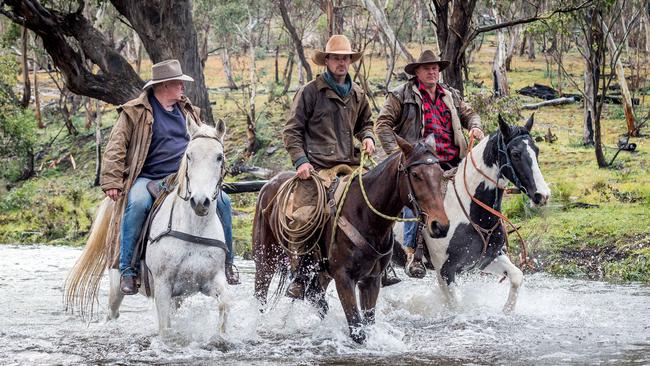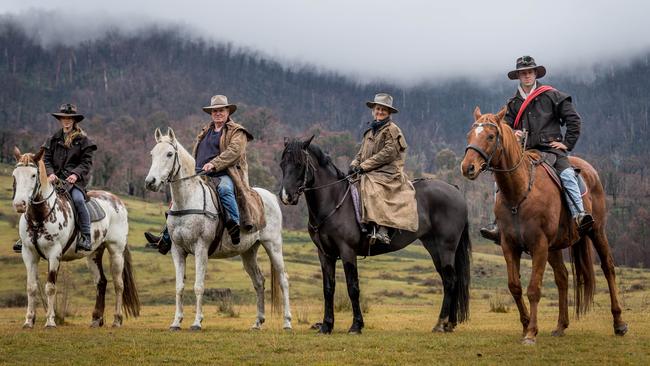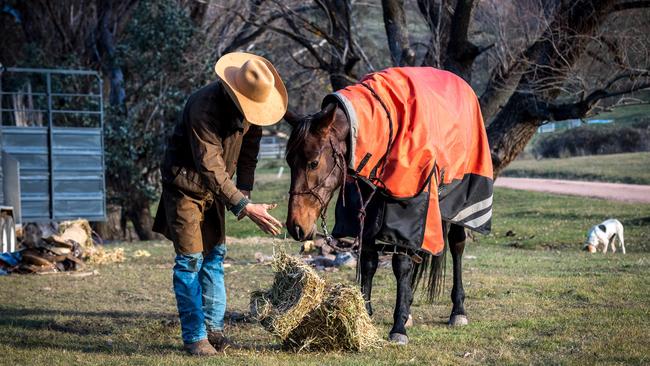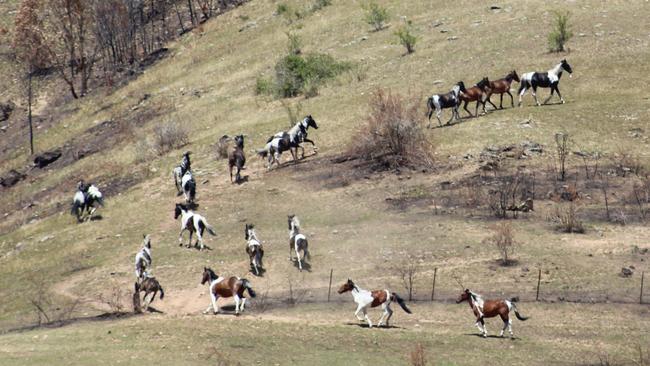Days of wild horses and Snowy River romance are numbered
When word passed around that shooters in helicopters were going to shoot and kill Bogong brumbies, it set the scene for the last great brumby muster. Then a court action at the eleventh hour stopped the cull — but only for now, writes Andrew Rule.
Andrew Rule
Don't miss out on the headlines from Andrew Rule. Followed categories will be added to My News.
The buck stops here, at the end of a winding road nearly an hour past Omeo, last stop before the Bogong High Plains.
The word has passed around that the authorities are going to get their way, and that shooters in helicopters will kill the Bogong brumbies.
All the cracks have been invited to the fray, but some tried and noted riders have thought they’d better stop away. A few turn up late Wednesday despite the weather forecast.
Missing is a Pendergast from up by Kosciusko’s side, where the hills are twice as steep and twice as rough. His excuse: he’s not allowed to cross the border his pioneer forebears crossed in the 1830s. But Carol Faithfull, whose ancestors also rode in from the Monaro 190 years ago, brought her horse.
There’s the Man from Tambo River, horsebreaker Lewis Benedetti, who lives at Mt Taylor. Lewis turns the better brumbies into kids’ ponies and stock horses.

The Man from Thomson River hasn’t arrived yet — he’s a Boulton, whose family has chased brumbies for two generations. Like Clancy of the Overflow, the Boultons and Kellys learned to ride while droving on the plains.
For every brumby runner gathered here at Bundara there’s a camera. Apart from an ABC film crew, there’s the Man from Yarra River, a national magazine writer with photographer in tow.
There are representatives of the New York Times. Foreign correspondents love hard riding where the wild bush horses are. They know it make great pictures — think cowboys lassoing mustangs in kangaroo country. But California it ain’t: on Thursday the cloud is low, it’s threatening to snow and the rescue plan hits a hurdle.
It seems the media people have come from stations near and far to shiver around a fire and frown at the sullen sky.
This was meant to be the last great brumby muster, a scene straight from The Man From Snowy River.
The idea, easily promoted but hard to pull off, was to rescue the Bogongs mob by mustering and moving them to private property before the helicopters and rifles moved in.
The cull was planned for this week, before it was postponed by eleventh-hour court action. The shooting will probably go ahead in winter when conditions might discourage protesters. The fact the proposed rescue bid struck bad weather this time makes that more likely, as it will get harder to muster enthusiasm to muster brumbies in freezing conditions.
Of course, if the weather is too bad, it will be too risky for helicopter pilots and shooters, too. But the day will come when the choppers will fly and the Snowy River romance gets the bullet.

That doesn’t mean the Australian Brumby Alliance and its patchwork quilt of supporters are giving up. Among them — though not necessarily agreeing with everything the alliance stands for — is brumby-catching royalty.
These are the Connleys, the best-known surname in “buck running”, as they call it in the high country, where catching brumbies is somewhere between sport, a paying hobby and a way of life. It is also a way to thin out the wild horses, which mountain cattlemen routinely did before they lost their summer grazing leases on the high plains.
Ron Connley is the oldest surviving member of a family of horsemen and women who have ridden the high plains and mountain valleys for more than a century.
Ron was the world champion rodeo steer wrestler, when it was called bulldogging, and has done just about everything that can be done on horseback. But he has just got out of hospital with a broken pelvis, thanks to a young horse bucking as he mounted. This can happen if you’re breaking in horses at 80.
He’s using a walking stick for the first time in his life, and looking forward to getting back in the saddle — although maybe not on a youngster that bucks quite so readily.
If it wasn’t for broken bones and doctor’s orders, there’s a fair chance Ron would have ridden into the bush to look for brumbies sheltering from the weather in distant gullies, something he knows by experience and instinct.

His son Charlie Connley is with him. Like the rest of them, he’s a horseman. But there’s a big gap in the group. Missing, and much missed, is Ron’s younger brother Ken. The man who has roped more brumbies than anyone in Australia can’t make it from his sick bed across the hills at Benambra.
Ken Connley was 18 when he started counting brumbies he’d caught. But he had actually begun catching them when he was 14, so the 1300-plus tally in his “brumby book” should have at least another 100. Some years, he caught 130, and often averaged one a week. He broke in a lot to be sold as riding ponies. Poor specimens went to the saleyards, providing cash that helped feed the kids in drought years.
This year, cancer has done what no horse ever did — keep him out of the saddle.
The Connleys (there were five brothers) and their descendants have caught thousands of brumbies between them over 60 years.
They always looked as if they stepped from the Paterson poem in their Drizabone coats and big hats. Ken was recruited as a stunt double for the actor Jack Thompson in the hit film The Man From Snowy River in 1982.
The Connleys know as much as anyone alive about the Bogong mobs being targeted in the first skirmish of a war to rid Victoria’s eastern alps of growing numbers of brumbies.
Ron Connley says that once the wild horses bolt into the rocks on the Bogongs “you can bid the mob good day”, as the poem goes. It’s been that way ever since the pioneer families, McNamaras and Youngs, grazed 2000 horses on the high plains every summer to sell to the Indian and Australian armies.

These were among the famous “Walers” bred for the remount trade, exported in tens of thousands before and during World War I. When the trade collapsed between the wars, unwanted runaways stayed on the high plains and bred. Their wild descendents, say brumby boosters, is the last “pure” genetic link with the local Walers sent off to war.
In those days, before 20 generations of in-breeding, inconsistent nutrition and seasonal starvation, they were well-bred and valued horses. Ron Connley can still name McNamara’s foundation stallions, and remembers seeing two of them when he was a boy.
One was a pony stallion called Billy Illes, whose progeny were prized. The other was the piebald stallion who is the forebear of hundreds of “coloured” horses still in the high country, both as brumbies and as stock horses used to chase them.
One of that bloodline, Johnny Reb, emerged from backblocks Omeo to be Australian champion showjumper in 1971 and was due for Olympic selection when fatally injured. They took the champ home to East Gippsland’s blue hills to bury him. His grave, at Buchan, is marked with a nameplate in the shape of a horseshoe.
Ken Connley and a not-so-silent partner Phil Maguire run stock on the property at Bundara. Among them are a couple of dozen piebald and skewbald brumbies that wander in and out of the bush, all descended from the same line that produced the great Johnny Reb. The Connleys and other mountain people have grown up with brumbies and brumby running. It is part of their life, and they are torn between the practical realities of the present and memories of the past.
Ken Connley is unlikely to catch another horse. At 74, between visits to his specialist, he thinks about better days. One of his favourite “buck running” horses, he says, was a skewbald stallion with enormous stamina. He, like Johnny Reb, was the same bloodline as some of those multi-coloured horses he caught.

Like an angler who releases fish back into the water, Connley bred some colts by the stallion and turned them out into the bush to improve the brumby breed. It is hard for him and brother Ron and the other mountain people to imagine a time when the mountain brumbies would be completely shot out, which is what the government wants to do.
But they are livestock people, and know there’s a case for thinning them out, which is different from eradication.
Ask Ron about the wild horses and he says there are too many of them, and that the breed has deteriorated.
He agrees with other cattlemen that there are too many feral horses in the eastern alps, from Omeo to Gelantipy to the border. But, funnily enough, he says there are not that many on the Bogongs, because it is such a tough place to survive winters.
“We went up there with pack horses last year,” he says. “We saw about 30 horses and there wouldn’t be more than 50 there. They’re really inbred now. Just little brumbies.”

